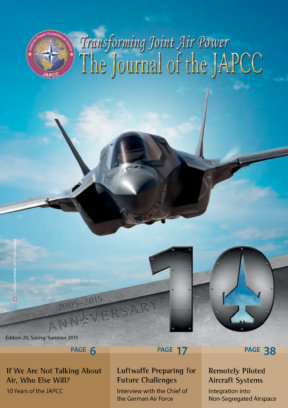Editorial
As the Director of the Joint Air Power Competence Centre (JAPCC), it is my pleasure to introduce the 20th Edition of ‘The Journal of the JAPCC’. In this special edition, we celebrate the JAPCC’s 10th Anniversary by featuring articles reflecting on our past as the first NATO accredited Centre of Excellence and also looking forward to the future of Joint Air and Space Power.
Our Executive Director, Lieutenant General Joachim Wundrak, leads off this anniversary edition by revisiting the history and JAPCC’s impact with decision-makers. The Assistant Director, Air Commodore Madelein Spit, continues with a look back on the invaluable leadership which enabled the JAPCC to overcome early obstacles and achieve its present level of success. She also includes perspectives from former Directors, Executive Directors and Assistant Directors on the centre’s contributions to Joint Air & Space Power. Finally, the interview with Chief of the German Air Force, Lieutenant General Karl Müllner, discusses structural reforms in the German Armed Forces and the challenges faced by both the Luftwaffe and its NATO Allies in the post-ISAF environment.
The JAPCC also continues exploring our space education and training efforts with two articles discussing space situational awareness. The first, ‘A Model of Space Debris Environment’, illuminates the growing concern for space debris and presents a model to estimate impact on various satellite orbits. The second article, simply titled ‘Space’, articulates the modern military dependency on space capabilities and the unique advantages they bring to the fight.
The future of Remotely Piloted Aircraft Systems (RPAS) is another expanding field in which we are greatly interested. This 10th anniversary edition presents an article on RPAS integration into Non-Segregated Airspace. A second article, entitled ‘Platform Autonomy’, examines the various levels of autonomy and their future implications.
The role of enhanced training and exercises will be critical to the increased readiness, availability and interoperability of the Allied Forces. The article ‘Exercise Virtual Magic’ educates us on an initiative to improve E-3A and E-3D training with Mission Training through Distributive Simulation (MTDS). Additional articles also describe how innovative programs can affordably solve training problems. The ‘Be advised, Training in Progress’ article describes a new Specialized Heavy Air Refuelling Course (SHARC) designed to train Air to Air Refuelling planners. Finally, ‘The Multinational Aviation Training Centre (MATC)’ article explains how this NATO Smart Defence project is providing invaluable training in response to years of combat operations in Afghanistan.
Finally, the article ‘Doing the Same with Less – Potential Synergies for NATO Air Power’ takes a new look at fiscal constraints and how they impact Air and Space Power.
I congratulate the authors on their contributions to this 10th Anniversary Journal. I strongly encourage you to consider their efforts as we move forward and advocate for Joint Air Power.
The JAPCC team greatly appreciates your feedback and thoughts. Please visit our website at www.japcc.org, where you will find contact information and additional Air & Space Power content.
Frank Gorenc
General, US AF
Director, JAPCC








